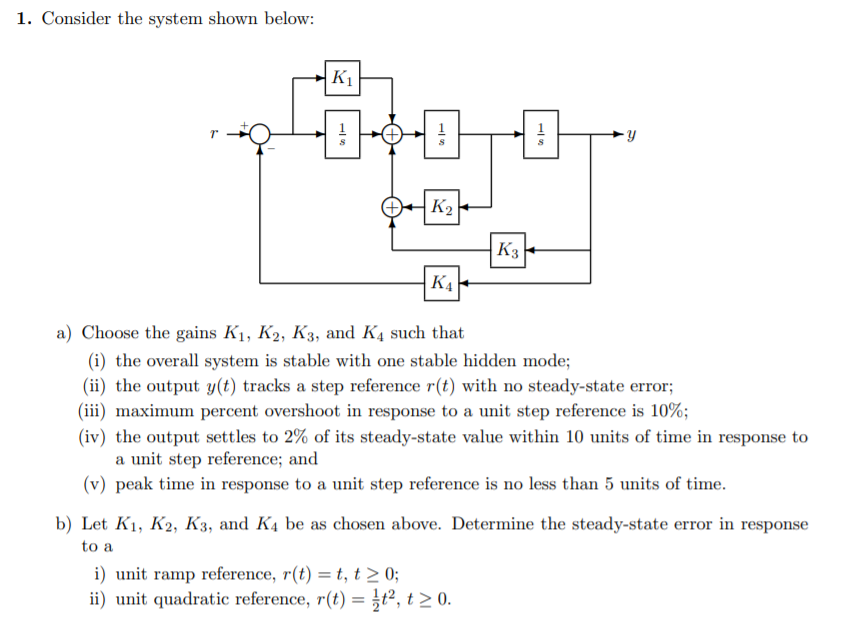1. Consider the system shown below: |K1 K2 K3 K4 a) Choose the gains K1, K2, K3, and K4 such that (i) the overall system is stable with one stable hidden mode; (ii) the output y(t) tracks a step reference r(t) with no steady-state error; (iii) maximum percent overshoot in response to a unit step reference is 10%; (iv) the output settles to 2% of its steady-state value within 10 units of time in response to a unit step reference; and 1/5
1. Consider the system shown below: |K1 K2 K3 K4 a) Choose the gains K1, K2, K3, and K4 such that (i) the overall system is stable with one stable hidden mode; (ii) the output y(t) tracks a step reference r(t) with no steady-state error; (iii) maximum percent overshoot in response to a unit step reference is 10%; (iv) the output settles to 2% of its steady-state value within 10 units of time in response to a unit step reference; and 1/5
Introductory Circuit Analysis (13th Edition)
13th Edition
ISBN:9780133923605
Author:Robert L. Boylestad
Publisher:Robert L. Boylestad
Chapter1: Introduction
Section: Chapter Questions
Problem 1P: Visit your local library (at school or home) and describe the extent to which it provides literature...
Related questions
Question

Transcribed Image Text:1. Consider the system shown below:
K1
K2
K3
K4
a) Choose the gains K1, K2, K3, and K4 such that
(i) the overall system is stable with one stable hidden mode;
(ii) the output y(t) tracks a step reference r(t) with no steady-state error;
(iii) maximum percent overshoot in response to a unit step reference is 10%;
(iv) the output settles to 2% of its steady-state value within 10 units of time in response to
a unit step reference; and
(v) peak time in response to a unit step reference is no less than 5 units of time.
b) Let K1, K2, K3, and K4 be as chosen above. Determine the steady-state error in response
to a
i) unit ramp reference, r(t) = t, t > 0;
ii) unit quadratic reference, r(t) = }t², t > 0.
Expert Solution
This question has been solved!
Explore an expertly crafted, step-by-step solution for a thorough understanding of key concepts.
This is a popular solution!
Trending now
This is a popular solution!
Step by step
Solved in 3 steps with 14 images

Knowledge Booster
Learn more about
Need a deep-dive on the concept behind this application? Look no further. Learn more about this topic, electrical-engineering and related others by exploring similar questions and additional content below.Recommended textbooks for you

Introductory Circuit Analysis (13th Edition)
Electrical Engineering
ISBN:
9780133923605
Author:
Robert L. Boylestad
Publisher:
PEARSON

Delmar's Standard Textbook Of Electricity
Electrical Engineering
ISBN:
9781337900348
Author:
Stephen L. Herman
Publisher:
Cengage Learning

Programmable Logic Controllers
Electrical Engineering
ISBN:
9780073373843
Author:
Frank D. Petruzella
Publisher:
McGraw-Hill Education

Introductory Circuit Analysis (13th Edition)
Electrical Engineering
ISBN:
9780133923605
Author:
Robert L. Boylestad
Publisher:
PEARSON

Delmar's Standard Textbook Of Electricity
Electrical Engineering
ISBN:
9781337900348
Author:
Stephen L. Herman
Publisher:
Cengage Learning

Programmable Logic Controllers
Electrical Engineering
ISBN:
9780073373843
Author:
Frank D. Petruzella
Publisher:
McGraw-Hill Education

Fundamentals of Electric Circuits
Electrical Engineering
ISBN:
9780078028229
Author:
Charles K Alexander, Matthew Sadiku
Publisher:
McGraw-Hill Education

Electric Circuits. (11th Edition)
Electrical Engineering
ISBN:
9780134746968
Author:
James W. Nilsson, Susan Riedel
Publisher:
PEARSON

Engineering Electromagnetics
Electrical Engineering
ISBN:
9780078028151
Author:
Hayt, William H. (william Hart), Jr, BUCK, John A.
Publisher:
Mcgraw-hill Education,